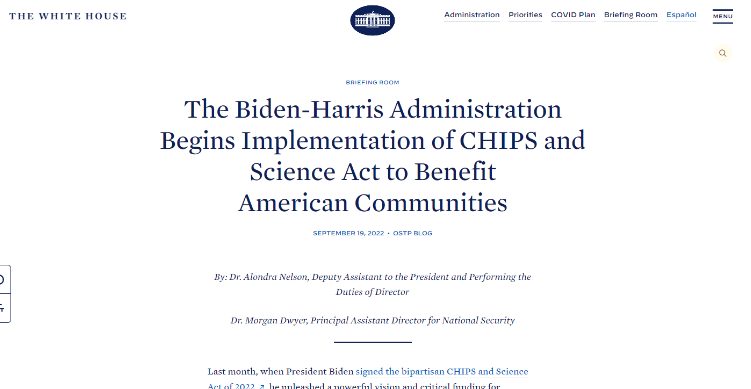(This article appeared as an OSTP BLOG post on September 19, 2022.)
By: Dr. Alondra Nelson, Deputy Assistant to the President and Performing the Duties of Director, Dr. Morgan Dwyer, Principal Assistant Director for National Security
Last month, when President Biden signed the bipartisan CHIPS and Science Act of 2022, he unleashed a powerful vision and critical funding for semiconductor investments that will power American infrastructure, grow and diversify our workforce, and enhance science and technology research and development for years to come.
Following the historic signing of the CHIPS and Science Act, the President issued a subsequent Executive Order on the Implementation of the CHIPS Act of 2022. This Executive Order established an Implementation Steering Council to coordinate policy across all of the CHIPS Act commitments and investments. As a co-chair of this steering council, along with the National Economic Council and the National Security Council, the Office of Science and Technology Policy (OSTP) will provide significant guidance and deep technical subject-matter expertise.
In further support of this implementation effort, the Department of Commerce launched CHIPS.gov to serve as an essential location for timely, accurate information for the public on processes related to CHIPS program initiatives. There you can find CHIPS for America, the implementation strategy for the CHIPS for America Fund, a $50 billion investment to catalyze long-term growth in the domestic semiconductor industry in support of our national and economic security and a thriving science and technology enterprise.
Finally, just over a week ago, the President’s Council of Advisors on Science and Technology, PCAST, held a public meeting to discuss its forthcoming report on revitalizing the U.S. semiconductor ecosystem.
These latest implementation efforts build on the CHIPS for America Act of 2021 that established the National Science and Technology Council’s Subcommittee on Microelectronics Leadership (SML), initiating the development of a Draft National Strategy on Microelectronics Research, and several other key activities.
Since its establishment more than a year ago, the SML, which is co-chaired by OSTP, the Department of Commerce’s National Institute of Standards and Technology (NIST), and the Department of Defense’s Defense Advanced Research Projects Agency (DARPA), has been preparing for the recently passed CHIPS appropriations by engaging with more than a dozen Federal agencies and departments to better understand their microelectronics research and development (R&D) priorities, and how they apply to agency missions, and, importantly, to the public interest.
At OSTP, we see abundant promise in the CHIPS and Science Act, and we are laser-focused on supporting the Biden-Harris Administration and all agency partners to positively benefit communities through major initiatives across key pillars such as job creation, science and technology R&D efforts, equitable STEM outreach, education, and workforce initiatives, and more.
Given the importance of the historic opportunities enabled by the CHIPS and Science Act, and to kick off an important step in the implementation phase, OSTP has issued a Request for Information for public comment on the Draft National Strategy on Microelectronics Research developed by the SML. OSTP is seeking input from stakeholders from across the microelectronics ecosystem including industry, academia, and non-profits to guide this effort. You can find the Request for Information here and the draft strategy here.
These public comments will inform the SML as it looks to prioritize microelectronics R&D investments; to leverage and connect the broader R&D infrastructure; to enhance public-private partnerships and international engagements; to equitably train educate, train, and build the workforce; and to develop activities that address future challenges to the innovation, competitiveness, and supply chain integrity of the United States in the field of microelectronics.
This strategy will ultimately provide guidance for agency leaders, program managers, and the research and innovation community regarding the planning and implementation of their microelectronics R&D investments and activities, and ensure they are synergistic with the broader CHIPS legislation, investments, and activities.
By collaborating across agencies to identify the most pressing R&D challenges the Federal government should prioritize now, Federal agencies can be better positioned to enable the visionary innovations and discoveries of tomorrow. These advances, further enabled by the Science portion of the CHIPS and Science Act, will also take the shape of foundational discoveries in critical and emerging technologies such as bio- and nano-technology, quantum information science, and artificial intelligence, as well as partnerships with Hispanic Serving Institutions, Historically Black Colleges and Universities, Tribal Colleges and Universities, emerging institutions, and underserved communities across the United States.
The CHIPS and Science Act of 2022 is a substantial investment in America’s future. The robust R&D ecosystem it will empower, the large and diverse workforce it will train, and the critical infrastructure it will build all have the potential to positively transform society in the coming decades.
Ensuring that Federal R&D funding is targeted to the right challenges today and tomorrow is crucial to building a future that is equitable and where opportunities for health and prosperity are limitless for all. We welcome your input into this historic effort.
###


